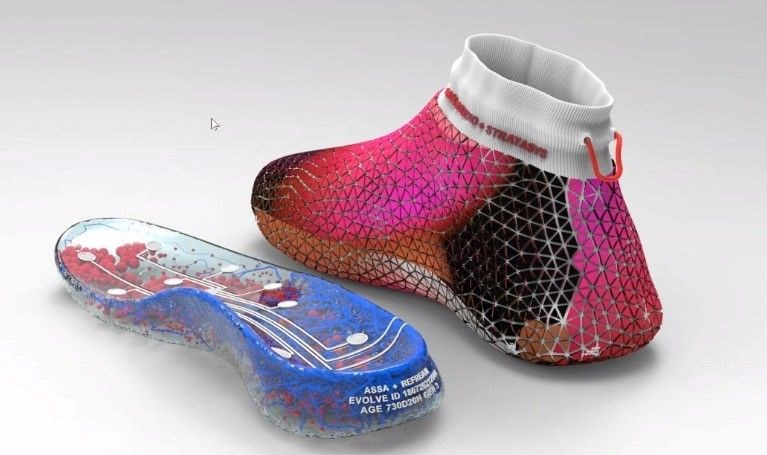Stratasys presents two original research projects with renowned designers Assa Ashuach, Filippo Nassetti and Vincenzo Reale that radically re-envision footwear and face mask design through direct-to-textile 3D printing. Through the use of embedded sensors, biomechanically realistic 3D printing materials, and Stratasys J850™ 3DFashion™ printers, the new designs bring greater inclusivity, personalisation, sustainability, and aesthetics to fashion. The projects were enabled through Re-FREAM, an EU-funded collaborative research group with the support of engineering and research companies such as Profactor, Haratech, and Empa. The research project focused on bringing art and industry together to allow artists, designers, engineers and scientists to co-explore the use of 3D printing technologies for the future of fashion.
Assa Ashuach’s research project explored conceptual footwear design and manufacturing methodologies resulting in two shoe designs that address sustainability as well as personalisation. Assa focused on the development of material combinations as well as fabrication methods to create sustainable alternatives to current designs. The footwear designs include an evolutionary artificial intelligence (AI) chip that records and stores wearers’ data in real time and uses this information to inform the next generation production.
The Evolve shoe contains a personalised midsole ‘Evolve Sensor’ that studies its wearer while recording their movement data (foot inclination, temperature, pressure and friction, etc.). The information collected through the sensor is used by the production team to create the next generation of shoe which will therefore include improved design features based on performance.
“We can research and develop an improved and sustainable design methodology that offers greater value to the user. This is achieved by changing current practices and making one bespoke pair of shoes rather than thousands of pairs sent to market in standard sizes,” says Assa Ashuach, Architectural Designer. “This project is also about a new kind of essential sensitive information exchange. We are asking the user to disclose personal biometric and ergonomic data and in return we deliver an enhanced footwear design that functions better on the domains of physical and visual bespoke performance.”
The Sepiida shoe leverages the technologies of the Evolve shoe, including its rubber-like midsole, while taking design inspiration from the internal shell of the cuttlefish, resulting in a “shoe sock.” The upper sock-like section of the design was printed directly on textile using the Stratasys J850 3DFashion printer, which allowed for greater control over visual effects and material properties such as aerodynamic stretchability and durability.
Filippo Nassetti, Architect and Generative Designer at Zaha Hadid Design, and Vincenzo Reale, Generative Designer and Engineer at Arup, design wearable technology through radical innovation by rethinking how technology interfaces with the human form. Their research project explored the face mask in the new global environment and how personal identities have changed in the post-pandemic era. The Thalassic Mask was designed as a symbolic expression of individuality and anonymity with inspiration taken from underwater marine environments, something they describe as “post-natural.”
Nassetti and Reale recreated the design expression of coral reefs found in the ocean and embedded it in their mask collection. The research sought to find the perfect balance between fabric draping and visibility, which required a deep understanding of the weight, rigidity, and geometry needed for the final design. Combined, these factors would influence the pull on the textile and the unique fold for the final facial fit. The design had to be both functional and aesthetically pleasing with an attractive pattern that aligned correctly with the facial features beneath the mask.
The Thalassic design was manufactured using the Stratasys J850 3DFashion printer directly on chiffon fabric. To allow for the free-flowing movement of the textile, the geometrical design elements had to be streamlined to achieve the desired fluidity. This required the perfect choice of textile, design elements, and 3D-printed materials to ensure harmony and curvature with the face of the wearer.
“The Thalassic mask, inspired by the experience of the pandemic and the restrictions of staying at home, celebrates equality by masking personal differences and shining a light on humanity. Fashion has always been a vessel for self-expression and differentiation, and we are excited that the innovation of 3D printing on textile is part of this project.” Kaempfer says.
Click here to learn more about the Postnatural Prostheses - The Thalassic Mask project.
The Stratasys J850 3DFashion printer is one of the most versatile full-colour printers on the market. The patented printer supports over 600,000 Pantone® Validated™ colours and uses innovative algorithms to produce different nuances of hue and tonality. The company is focused on setting new trends in the fashion industry by creating garments, shoes, and accessories through innovative 3D printing technology.
Learn more about how Stratasys is creating 3D-printed art.



